What Are Microservices: Pros, Cons, Use Cases, and More
 I Len
I LenTable of contents
- What are microservices?
- How does microservice architecture work?
- Comparison of Microservices with Monolithic and SOA architecture
- What are the benefits of microservices?
- What are the challenges of microservices?
- 5 Best practices for implementing a microservices architecture
- Key enabling technologies and tools
- How to monitor microservices?
- How do microservices enable and require DevOps?
- Real-world examples of microservices
- Misconceptions about microservices
- When should you use microservice architecture?
- When should you not use microservice architecture?
- What does the microservice architecture look like in 2023 and beyond?
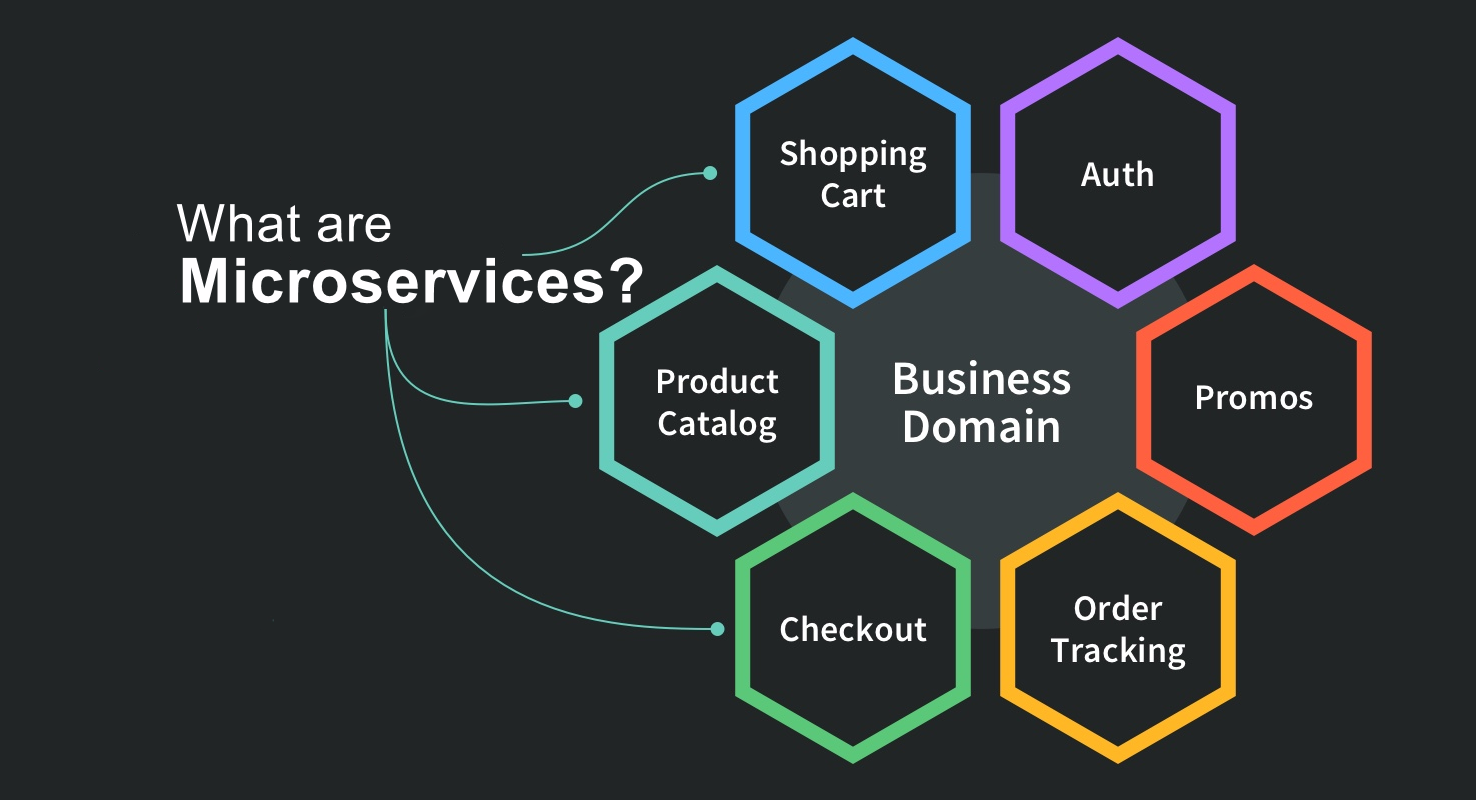
Learn extensively about microservices architecture for rapid, frequent, & reliable delivery of large & complex applications and reduce costs.
Quick Summary: A microservices approach to application development enables IT organizations to be more agile and expedite time to market. But you have to be cautious while breaking an app into fine-grained services. Here’s everything you should know.
What are microservices?
Microservice architecture is a software design pattern that decomposes the extensive app into various independent services that interact via APIs. As a result, you can have an autonomous team for developing and maintaining independent services, so scaling becomes easier.
You can also think of microservices as an extension of SOA (Service-Oriented Architecture). You can create various independent services using different programming languages and platforms. It enables the rapid, frequent, and reliable delivery of large and complex applications.
In short, microservices are a collection of services that are:
Loosely coupled
Highly maintainable and testable
Organized around business capabilities
Independently deployable
Owned by a small team
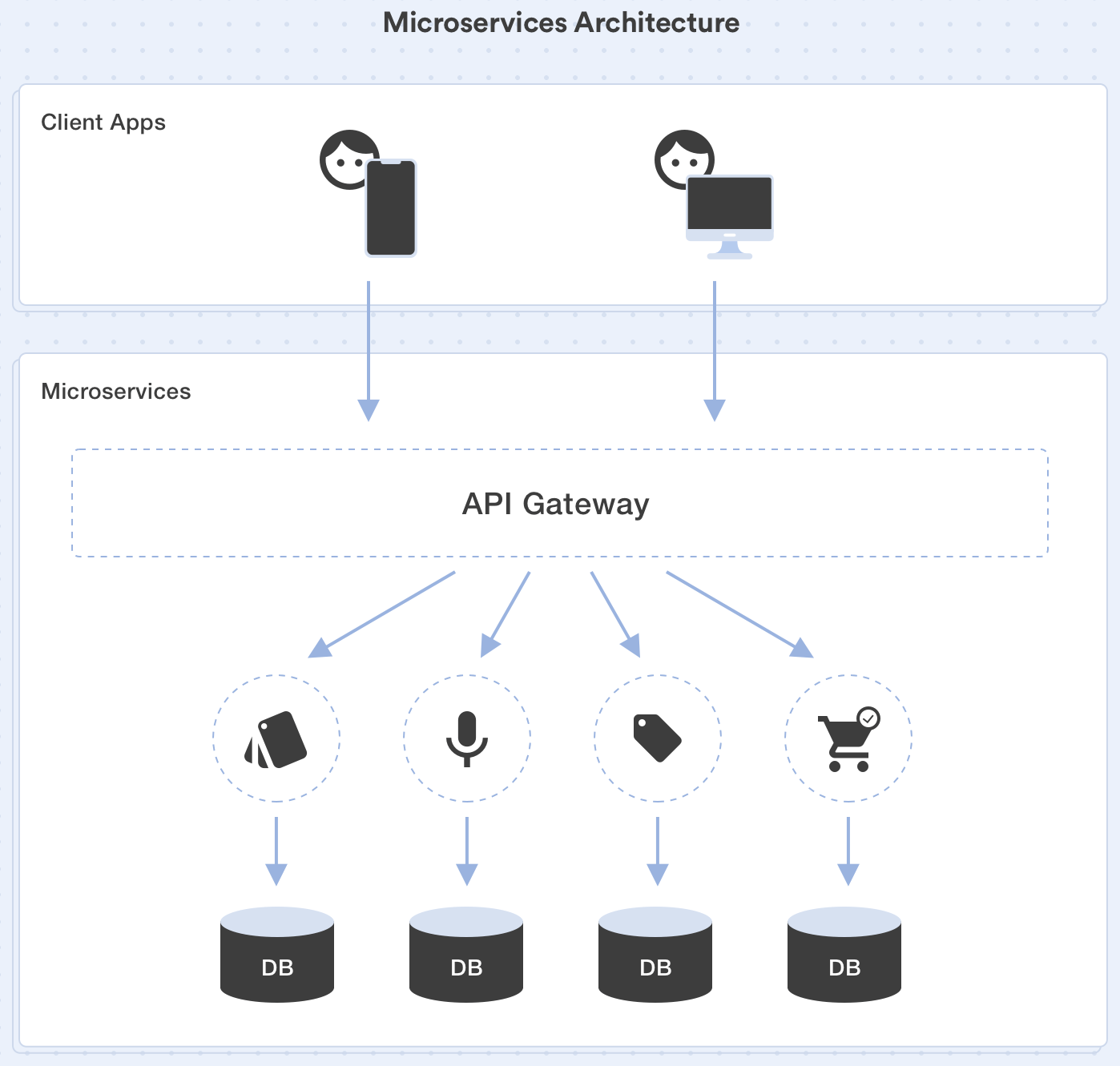
Many organizations have embraced Conway’s Law to leverage the power of distributed teams and create efficient microservice architecture. Given below are some common characteristics that most microservice architectures exhibit.
Characteristics of Microservices
Each service has a separate database layer, independent codebase, and CI/CD tooling sets.
Services are responsible for preserving their data or external state.
Every service is independently deployable and can be tested in isolation without depending on other services.
Internal communication between the services happens via well-defined APIs or any lightweight communication protocol.
Each service can select the technology stack, libraries, and frameworks best suited for its use cases.
Services should implement Retry functionality if there is a network or system failure.
Before building a microservice, you must also know the myths and confusions to enjoy the whole range of benefits that we’ll discuss later on.
How does microservice architecture work?
Microservice architecture is an approach to software development where an application is built as a collection of small, independent services that communicate with each other through APIs. Each service is responsible for a specific business capability, allowing for flexibility, scalability, and easier maintenance of complex systems.
Let us explore how it works using an eCommerce storefront as an example:
Step 1: Decompose the Monolith
In a microservice architecture, the first step is to break down the monolithic application into smaller, loosely coupled services. For an eCommerce store, this means separating services for user management, product catalog, shopping cart, order processing, payment, and inventory management.
Step 2: Define Service Boundaries
Next, clearly define the boundaries and responsibilities of each microservice. Each microservice handles a specific business capability. For instance, the user management microservice takes care of user registration, authentication, and profile management.
Step 3: Communicate via APIs
Microservices communicate with each other through well-defined APIs. Each microservice exposes APIs that others can use to request or provide data. This enables independent development and deployment.
Step 4: Use Independent Data Storage
Each microservice has its dedicated data storage optimized for its specific needs. This enables independent data management for each microservice. For example, the user management microservice may use a relational database to store user information, while the product catalog microservice utilizes a NoSQL database to store product details.
Step 5: Ensure Fault Isolation and Resilience
Microservices should be designed to be fault-tolerant and resilient. If one microservice fails, the rest of the system remains unaffected. Failures should be isolated and gracefully handled.
For example, If the payment microservice encounters an error during a transaction, it should not impact the availability of other services. The system should handle the failure gracefully, display an appropriate error message, and provide options for the user to retry or choose an alternative payment method.
Step 6: Scale Independently
Microservices allow independent scaling based on specific needs. If a particular service experiences high demand, it can be scaled independently without affecting other services.
For instance, if the product catalog microservice is experiencing high traffic due to a sale, it can be scaled independently by adding more instances or using load-balancing techniques to distribute the load.
Step 7: Monitor and Manage
Monitoring and managing each microservice is crucial to ensure performance, availability, and security. Implement appropriate monitoring tools and techniques to track the health and performance of each microservice.
In an eCommerce store, monitoring tools can track each microservice’s response times, error rates, and resource utilization. This allows for proactive identification and resolution of any issues that may arise.
By following these steps, you can successfully implement a microservice architecture in an eCommerce store, achieving flexibility, scalability, and independent development of different functionalities. Each microservice operates independently, communicates through APIs, and can be scaled and managed individually.
Comparison of Microservices with Monolithic and SOA architecture
Three popular architectures — monolithic, service-oriented architecture, and microservices are mostly used to build a new application. We’ve already discussed microservices earlier, now let’s understand the other two.
Monolithic architecture – A monolithic application is developed as a single unit, where all features, functionality, and modules are tightly coupled for development, integration, and deployment.
Microservices vs monolithic
Microservices | Monolithic | |
Design | Independent services communicate via APIs | The complex app encompasses several tightly coupled functions |
Data consistency | Difficult to achieve | Easy to achieve |
Scalability | Independently scalable | Challenging |
Agility | High operational agility | Difficult to achieve operational agility |
Service startup | Relatively quick | Takes more time |
Finding failure points | Difficult | Easy |
Team communication | More complex | Comparatively straightforward |
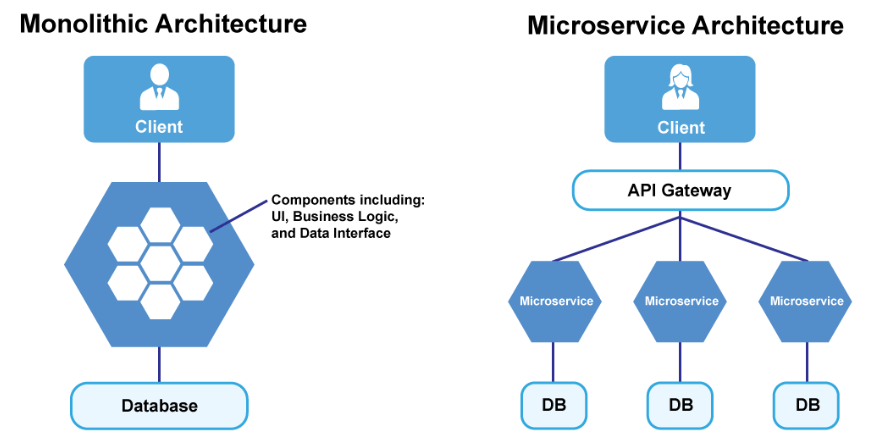
Service-oriented architecture – Created as a response to the traditional architectural approach, SOA helps decouple an overall application into smaller modules. These separate service modules intercommunicate to meet particular business requirements.
Often, many developers consider microservices as a subtype of SOA, while others insist each solves a different set of problems.
Microservices vs SOA
Microservices | SOA | |
Design | Services are built in small units | Services can vary in size from small to large |
Scalability | Independently scalable | A bit challenging due to dependencies between services & reusable sub-components |
Component sharing | Does not involve component sharing generally | Often involves component sharing |
Data storage | Each service can have an independent data storage | Involves sharing data storage between services |
Remote services | Uses REpresentational State Transfer(REST) and Java Message Service(JMS) | Uses protocols like Simple Object Access Protocol(SOAP) and Advanced Message Queuing Protocol(AMQP) |
Deployment | Quick and easy | Less flexible |
What are the benefits of microservices?
Microservices sit well with both cloud and DevOps. Let’s see how. Most companies nowadays are migrating their workloads to the cloud. Microservices allow software development teams to use patterns like event-driven programming and autoscale scenarios. The businesses also exhibit the same enthusiasm for adopting the DevOps strategy. DevOps practices also work by breaking large problems into smaller pieces and solving them one at a time. As a result, microservices perfectly fit into the DevOps.
Also, microservices provide independent scaling, easy deployment, technology stack flexibility, and faster time to market. Here are the 5 main benefits of microservices.
Agility – With microservices, small DevOps teams can work independently and act within a well-defined context, for faster development and increasing throughput.
Increased resilience and fault tolerance – When appropriately constructed, independent services do not impact one another. Service independence ensures that the failure of a specific service does not crash the enterprise application.
Higher-quality end product – Modularisation of an application into discrete components helps app development teams concentrate on a tiny part at a time. This approach simplifies the overall coding and testing process and increases software quality.
Real-time processing – A publish-subscribe framework of microservices enables data center processing in real time. As a result, extensible systems can consume and process large amounts of events or information in real-time.
Data isolation – Unlike a monolithic application, where different parts of the application might touch the same data, here, only a single microservice is affected. And so, it is much easier to perform schema updates.
What are the challenges of microservices?
The advantages of microservices that we’ve documented above don’t come for free. Like other transformational trends, microservices implementation poses its own threats. Without knowing these challenges, your organization might find it difficult to achieve many of the foreseen advantages.
Here are some of the challenges worth considering before taking a big leap.
Data consistency – Microservice has a distributed system approach to managing data, and if there is redundancy across the data stores, the same item of data appears in multiple places. Duplicated or partitioned data raises the issues of data integrity and consistency.
Distributed tracing – It’s challenging to find the failure point, debug, and fix sources of errors with microservices. Without a comprehensive full stack trace, you have to work backward and go through status codes and vague error messages.
Network congestion and latency – The use of multiple small, granular services will require more interservice communication. Besides, there can be the issue of additional latency if the chain of service dependencies becomes too long.
Operation overhead – Managing numerous independent services can often become a tedious task for the operation team. They need to put in significant effort to avoid any failures and ensure the resilience of the developed application.
Testing – Microservices testing is more complicated because of the complex integration, different services, and interdependencies. The testing team has to write many mock services to test even small units and should know various services and channels of communication to have full coverage in their test cases.

- Technical debt – A polyglot programming environment can often be a double-edged sword! While it allows architects and developers to build a microservices structure using individual infrastructures and different languages, the organization might end up with an enormous system having a thousand ways to deal with every single application.
5 Best practices for implementing a microservices architecture
The first essential step before working on the best practices is to determine whether microservices architecture is a good fit for your requirements. Then, get everyone on board with the idea once you’re sure of its practicality.
Here are the primary practices you should follow for organizing, designing, and implementing microservices architecture.
Have a dedicated infrastructure – A flawed design of the hosting platform would give poor results. By isolating your microservice infrastructure from other components, you’ll get fault isolation and best performance.
Have a dedicated database – Select the proper database, and customize the infrastructure it needs. Using a shared database for each microservice might not serve the purpose.
Attempt the migration in steps – The transition from monolithic to microservices can be pretty strenuous. Instead of jumping right in, you should first have enough new services in place. Then, break down the old application architecture into relevant components and migrate them one by one.
Align the right technology with the right microservice – Direct and iterative implementation of the technology allows you to make changes or replacements later. Consider maintainability, fault tolerance, scalability, cost of architecture, and ease of deployment while deciding on the appropriate technology.
Deploy in containers – A microservices architecture does not rigidly dictate the use of containers. However, by deploying microservices in containers, you need just one tool that knows how to deploy it. Also, this way, your application continues to respond better to unpredictable workloads, and you can achieve better server utilization rates.
In addition to all the above-stated practices, you should also clearly define CI/CD implementation processes, use asynchronous communication to achieve loosely coupled services, and bake application security into all phases.
Key enabling technologies and tools
As microservice is an architectural style, a single tool might not be sufficient to control the entire workflow. An organization should start by understanding the challenges of the existing tech stack and accordingly select a tool based on its functionality, license, benefits, and challenges.
Here are some of the development tools that help increase the developers’ productivity and play an essential role in microservice development.
Containerization platforms – Microservices become independently scalable and deployable by using isolated workload environments that containerization platforms provide. For example, a popular platform, Docker, enables you to containerize your microservices and simplify delivery and management.
Container orchestration platforms – Kubernetes (K8s) works wonders for automating the scaling, management, and deployment of microservice applications. This renowned framework allows you to manage hundreds or thousands of containers at a production scale.
API management tools – API gateways keep a single service lightweight by handling all requests from the clients and routing them to the appropriate microservice. They also help decrease microservices complexity, avoid exposing internal concerns to external clients and provide security benefits.
Messaging tools – REST/HTTP works well for synchronous request/reply patterns and public-facing APIs. However, it’s not suited for event-driven microservices. A message queue consists of messages sent between small independent services/applications, and it decouples heavyweight processing and smooth spiky workloads. Standard messaging tools are RabbitMQ and Kafka.
Data stores – The data store is used to preserve data needed by the microservices. Renowned session data stores are in-memory caches like Redis or Memcached.
Service mesh – You can deploy microservices without extensive knowledge of the underlying infrastructure by using a service mesh like Istio, which is quite popular in the Kubernetes community. It also provides additional capabilities like load balancing, intelligent routing, service discovery, policy enforcement, and more for your microservice architecture.
How to monitor microservices?
Monitoring the infrastructure and environment has always been an essential part of managing any IT system. On top of that, microservices-based applications have unique and more intensive monitoring requirements.
When building applications with microservice architecture, you have to manage a network of interrelated software components to ensure overall reliability. However, most traditional monitoring systems were designed for static application environments with fewer nodes. As a result, commonly prescribed monitoring tools like Graphite and StatsD that were in practice until recently are no longer enough to meet the new requirements.
However, Prometheus and Grafana have emerged as a popular combination for monitoring microservices. Prometheus works well with Kubernetes, and its inherent simplicity makes it ideal for mission-critical microservice-based.
How do microservices enable and require DevOps?
Organizations started embracing DevOps after realizing that agile transformation in application development falls short of meeting the agility needs of today’s markets that demand faster time-to-market. Over time, microservices architecture emerged from the DevOps practices of cloud-native companies to achieve quality and acceleration in software delivery.
While microservices deliver small pieces of functionality as a service, DevOps breaks software down into smaller segments to increase the quality and speed of software delivery. When combined, DevOps and microservices offer greater agility and operational efficiency. As per industry analysis, the DevOps & microservice ecosystem market will grow at a robust CAGR of 16% between 2017 and 2022 globally, reaching $10 billion by 2021**.**
The services-based approach of microservice architecture allows organizations to break down the application into smaller services. As a result, different teams can handle individual services as separate entities and simplify development, testing, and deployment.
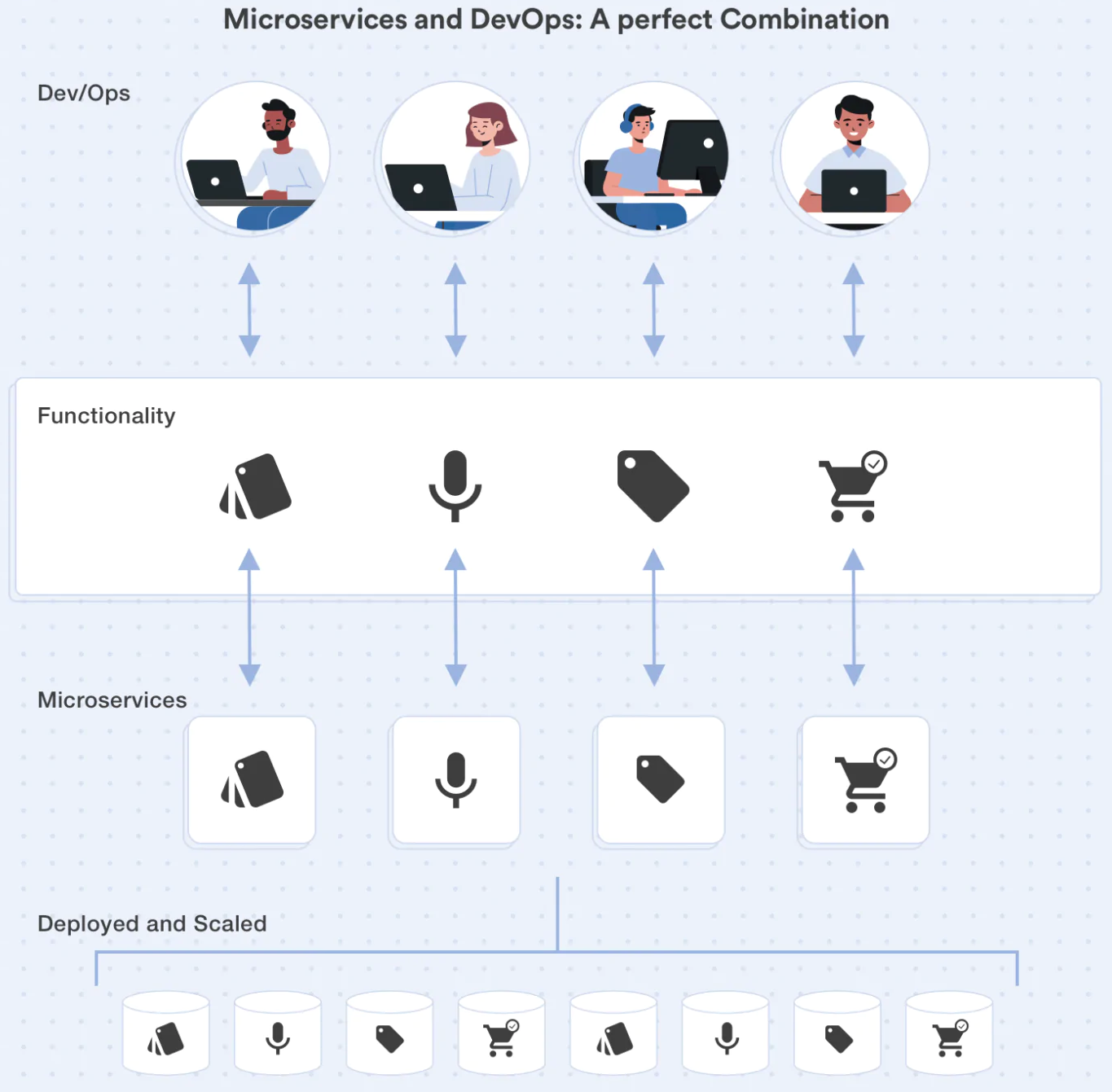
By combining microservices and DevOps, you can:
Develop cloud-native applications
Move developments to a flexible architecture
Increase productivity and quality of the application
Simplify monitoring and observability for developers
Accelerate innovation and reduce software development costs
Streamline the DevOps process
Real-world examples of microservices
Microservices can be beneficial for rapidly growing industries like an online marketplace, eCommerce, social media networks, finance, healthcare, etc. Some of the practical use cases for a microservice architecture include:
Adding new desired functionality to a large legacy system
Providing the scalability and control to handle big data
Enabling advanced analytics environments to validate their updated computational models using AB and multivariate testing
Collecting, aggregating, and analyzing a data flow for machine learning environments
Let’s see some famous microservices examples. Thanks to these tech giants, the world realized how disruptive the transition from monolith to microservices could be!
Netflix – Modern cloud computing-based companies consider Netflix a role model for using microservice architecture. The streaming giant started setting up its microservice architecture on AWS in 2009. Within two years, Netflix migrated from a monolith into microservices in phases. First, they transitioned movie encoding and other non-customer-facing small applications. Then they decoupled customer-facing elements such as movie selection, account sign-ups, device selection, and configuration.
Amazon – The World’s largest online retailer used to run on an extensive monolithic application with many modular yet tightly coupled components. As a result, Amazon could not split its teams into smaller groups and speed up its development cycle. Then, the company divided the code into independent functional services, wrapped with web services, and eventually progressed to microservices.
Best Buy – In 2010, Best Buy started transforming its eCommerce platform. Their mission was to break the monolithic, tightly coupled application into microservices for quick deployment of new features and react to market changes in the retail landscape.
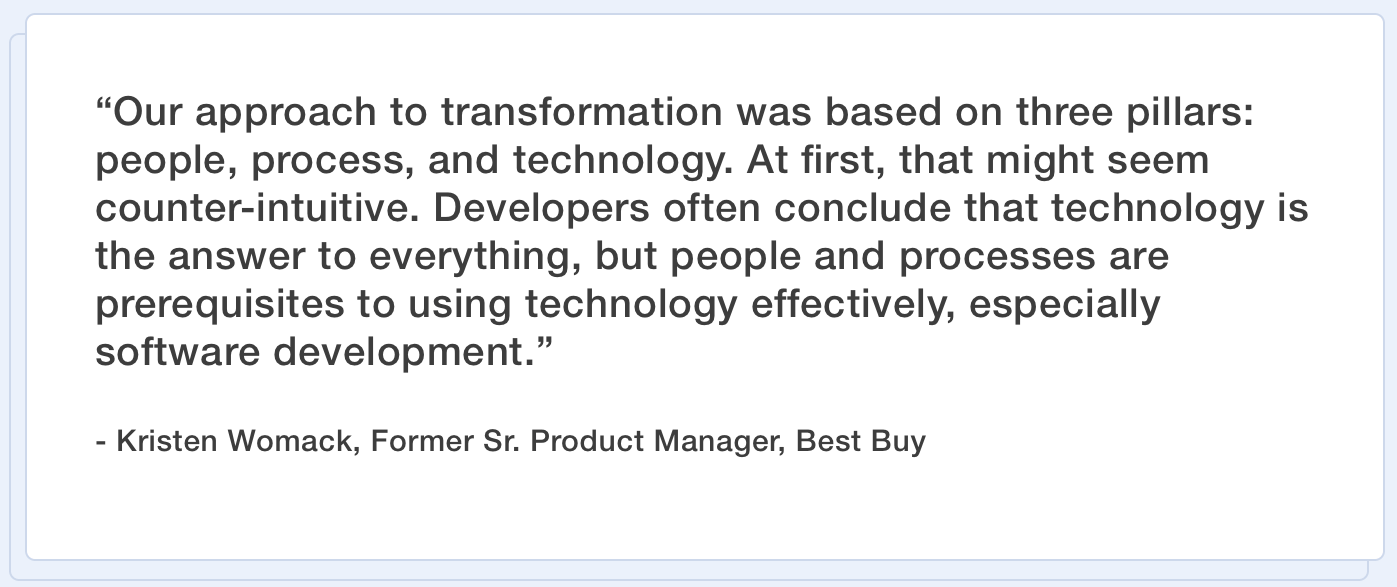
Let’s take an example of microservices for one of our clients, a fintech platform used by the UK’s leading financial companies. The company wanted to modernize its legacy applications. Having years of experience with various technologies, tools, and platforms, Our consulting team helped the company rebuild the front-end architecture. We also assisted with microservices API testing and OAS3 compliance testing.
Misconceptions about microservices
“Micro” means small – A microservice is comparatively “smaller” than the enormous monoliths. However, making it too small would be a mistake. The size of microservices generally depends on the application.
Microservices entirely eliminate complexity – Microservices shift complexity from code design and implementation into system operations where we can automate things.
Microservice can “easily” scale systems – Yes, scaling is undoubtedly an advantage here, but it’s not as easy as it sounds. Upscaling can involve managing several services simultaneously, and you have to ensure that the upscaled components integrate with the rest of the system.
Microservices work for all applications – One must evaluate systems and have long-term strategies before opting for microservices. Every application in an enterprise cannot be a good fit for a microservice.
When should you use microservice architecture?
When you want your monolithic application to adopt agility, scalability, manageability, and delivery speed.
When you have to update your legacy applications in today’s programming languages or tech stacks to keep pace with modern-day business requirements and solutions.
When developers are unable to predict the types of devices on which the app is going to run.
When your data management team is skilled enough to support the incorporation.
When you have standalone modules that you want to use across diverse channels.
If you’re developing a highly agile application that demands accelerated speed of delivery and innovation.
When should you not use microservice architecture?
If your business does not have complex issues.
If your application is simple by its nature and functionality and doesn’t need to be broken down into microservices.
If you do not have the proper tools and technologies like CI/CD pipeline in place.
If you do not have a robust system for monitoring and detecting issues for microservices.
If your team is not mature and is not willing to adapt the technical skills.
If you have a risk of running too many microservices.
What does the microservice architecture look like in 2023 and beyond?
The microservice architecture in 2023 and beyond presents a dynamic and transformative landscape. It is characterized by the convergence of cutting-edge technologies and the seamless integration of specialized services, revolutionizing the way digital systems are built and operated.
In this era, cutting-edge technologies collaborate with microservices to unlock remarkable possibilities. Serverless computing allows for seamless scaling, enabling microservices to adapt swiftly to fluctuating demands. Containerization, led by Docker and Kubernetes, empowers developers to build, deploy, and manage microservices with unprecedented ease and flexibility.
Artificial intelligence and machine learning fuse with microservices, delivering intelligent and personalized solutions. Smart assistants, chatbots, and recommendation engines become pervasive, enriching digital interactions. Blockchain technology finds its place, ensuring transparency and trust in microservice transactions.
Looking ahead, the Internet of Things (IoT) intertwines with microservices, orchestrating a symphony of connected devices. Industries such as smart homes, smart cities, and industrial automation rely on microservices for real-time data processing and decision-making.
In sectors like finance, healthcare, and e-commerce, microservice architecture demonstrates its remarkable effectiveness. Enhanced security, scalability, and rapid development cycles make it the go-to approach for enterprises seeking a competitive edge.
Embrace the future where microservices, driven by an array of transformative technologies, redefine the boundaries of possibility and revolutionize how we build and interact with digital systems.
Source: https://www.simform.com/blog/what-are-microservices/
Subscribe to my newsletter
Read articles from I Len directly inside your inbox. Subscribe to the newsletter, and don't miss out.
Written by
